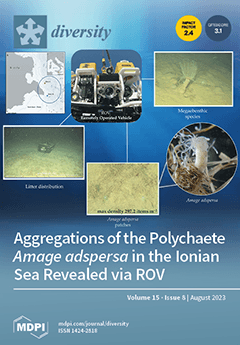The authors complete the study of the genus
Nama Borovec & Meregalli, 2013, one of the seven genera of the tribe Namaini Meregalli & Borovec, 2021, with the description of 14 new species:
Nama chaslavskae (type locality: North of Aggeneys, 29°12′ S 18°50′
[...] Read more.
The authors complete the study of the genus
Nama Borovec & Meregalli, 2013, one of the seven genera of the tribe Namaini Meregalli & Borovec, 2021, with the description of 14 new species:
Nama chaslavskae (type locality: North of Aggeneys, 29°12′ S 18°50′ E);
N. startorum (type locality: Danielskuil, 28°11′ S 23°33′ E);
N. ginobartalii (type locality: Messelpad Pass, 29°54′ S, 17°44′ E);
N. yusrae (type locality: Wildepaarde Hoek, 29°57′ S 17°33′ E);
N. goegapensis (type locality: Goegap Park, Kraaifontein, 29°37′ S, 18°02′ E);
N. semilunata (type locality: Gemsbok Vlakte frm., 30°30′ S 17°29′ E);
N. martiana (type locality: Aggeneys, Gamsberg, 1116 m, 29°15′S, 18°57′ E);
Nama smithi (type locality: Tswalu Kalahari Reserve, Pass South, 27°19′ S, 22°31′ E);
N. kostali (type locality: near Danielskuil, 28°15′ S, 23°34′ E);
Nama seriehispida (type locality: NE Bitterfontein, 30°53′ S, 18°19′ E);
N. khalidae (type locality: SW Kliprand, 30°40′ S, 18°41′ E);
N. switzerae (type locality: W Gamoep, 29°58′ S, 18°22′ E);
N. peternormani (type locality: Anenous Pass, 29°14′ S, 17°35′ E);
N. wallacei (type locality: Pofadder, 29°07′ S, 19°25′ E). Short biogeographical remarks are added.
Full article





